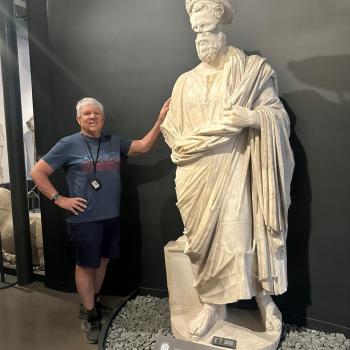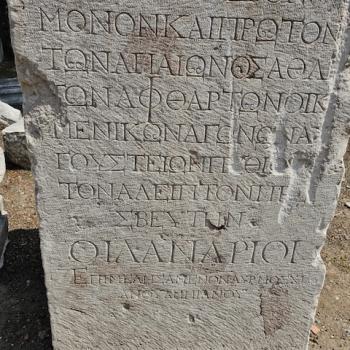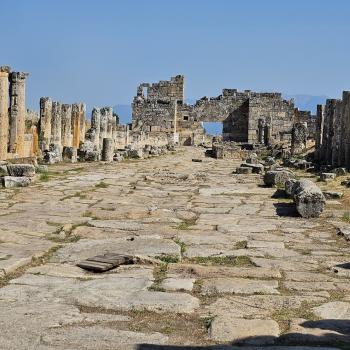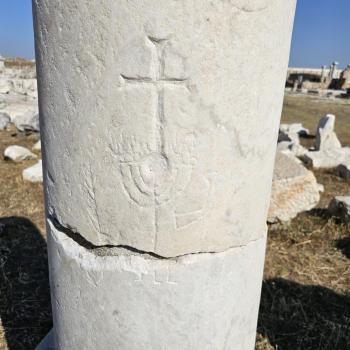 It would be hard to under-estimate the novelty and importance of the so-called Edict of Milan when it comes to religion in antiquity. I say so-called because it was neither an edict nor was it issued from Milan. What it was was official letters from two men who were ruling the Empire at the time— Licinius and Constantine. The letters were largely the same, one in Latin, one in Greek one posted in Nicomedia in 313, the Greek one in Caesarea a bit after that. The letter, written to provincial governors, mentions a consultation between the two rulers in Milan in which they agreed that the most important thing for the well being of the Empire and its security was “reverence paid to the Divinity”. When spelled out what this meant was that “it was proper that the Christians and all others should have liberty to follow that mode of religion which to each of them appeared best” (all quotes from Lactantius verbatim of the letter). This included the provision that “no one should be denied leave of attaching himself to the rites of the Christians or to whatever other religion…” and it was stressed that Christians ” are to be permitted freely and absolutely to remain in it, and not to be disturbed or in any way molested”. All things confiscated from Christians were to be returned, including buildings, land, sacred objects etc. This was far more than a cease and desist from persecution order.
It would be hard to under-estimate the novelty and importance of the so-called Edict of Milan when it comes to religion in antiquity. I say so-called because it was neither an edict nor was it issued from Milan. What it was was official letters from two men who were ruling the Empire at the time— Licinius and Constantine. The letters were largely the same, one in Latin, one in Greek one posted in Nicomedia in 313, the Greek one in Caesarea a bit after that. The letter, written to provincial governors, mentions a consultation between the two rulers in Milan in which they agreed that the most important thing for the well being of the Empire and its security was “reverence paid to the Divinity”. When spelled out what this meant was that “it was proper that the Christians and all others should have liberty to follow that mode of religion which to each of them appeared best” (all quotes from Lactantius verbatim of the letter). This included the provision that “no one should be denied leave of attaching himself to the rites of the Christians or to whatever other religion…” and it was stressed that Christians ” are to be permitted freely and absolutely to remain in it, and not to be disturbed or in any way molested”. All things confiscated from Christians were to be returned, including buildings, land, sacred objects etc. This was far more than a cease and desist from persecution order.
It is remarkable that some modern scholars have protested this remarkable dictum either on the grounds that it only promotes vanilla monotheism, or on the grounds that it is too explicitly in favor of Christianity, and so Constantine is charged with either being a syncretist or a theocratic Christian tyrant. You can’t have it both ways, and in fact neither is correct, as Leithart shows in Chapter 5. Perhaps the most remarkable clause is the statement that because of the very nature of religion, it should not ever involve coercion. It says all are to worship as they feel led ‘with free minds’ (liberis mentibus). It seems that Constantine was in fact about 14 centuries ahead of his time on this. In this Constantine is simply following the lead of the great Christian rhetorician Lactantius who was a mentor to Constantine and what Lactantius insisted on was “religion is first and foremost a matter of free will, and no one can be forced under compulsion to adore what he has no will to adore.’ Coercion only produces “a hypocritical show”. Now this remarkable and visionary view was completely at odds with the previous views of Emperors all the way back to the first century in this regard— when it came to the Imperial Cult especially from Decius on, worshipping the Emperor was not optional— it was obligatory, and it was precisely this fact that led to the widespread persecutions, unlike the sporadic and local ones in the first century. Roman policy could always allow for the adding of the worship of another deity, but allowing that in all religions in all respects “each one must freely do what is right in their own minds”, was something new, and in fact it was based in Lactantius’ reading of Paul and other parts of the Holy Scriptures. Constantine then neither banned paganism on the spot, nor did he ‘Christianize’ the empire in the sense of imposing Christianity on unwilling subjects. Neither of these things are true, as the so-called Edict of Milan shows and what this means is that the usual caricatures of Constantine are wrong. We may not much like the sort of Christian Constantine was— a Lactantian Christian, but he was definitely a Christian, and his tolerance laws were specifically set up to most protect Christians so they could freely worship God.
Lactantius, in responding to Porphry insisted that coercion pollutes true religion. “For religion is to be defended, not by putting to death, but by dying; not by cruelty, but by patient endurance, not by guilt, but by good faith: for the former belongs to evils, but the latter to goods; and it is necessary for that which is good to have place in religion, and not that which is evil. For if you wish to defend religion by bloodshed and by tortures, and by guilt, it will not longer be defended, but will be polluted and profaned” (Lactantius Divine Institutes 5.20). In fact it appears that Constantine took very seriously the notion that Christ set people free and was all about freedom. He says, upholding the Chi-Rho symbol of Christ and the cross “In this sign of salvation I have restored to Rome, her senate, and her people, heir ancient liberty and glory, delivering them from the lawless yoke of the tyrant” by which he meant the former ruler of Roman who had been intolerant of Christianity and would never have agreed with Constantine’s dictum. That is, Rome’s liberty, hence forth would only be secured ‘in this sign’. Christianity could be encouraged but pagans would have to be persuaded to follow Christ, not coerced but as for Constantine’s own direction, he made it clear. Just how remarkable a turn around this was can be seen from the fact that of course the cross and crucifixion was the Romans greatest symbol of shame, of dishonor, of criminality. Somehow, someway, Constantine had bravely seized the moment and declared it was now the key symbol of liberty if Rome’s people wanted to be free.
What kind of Emperor was Constantine? If we were to draw an analogy with aAmerican Presidents, I would say he would be on the one hand like Eisenhower being a military man and seeing no shame in that, but on the other, in terms of his own piety and his willingness to lecture his confidants and subjects on the goodness of being Christian, he would be more like the most devout Evangelical or Catholic President one could imagine– strong on defense at home and abroad, but always affirming the most important thing for the well being of the people was true religion and the free worship of the true God. Constantine has wrongly been portrayed as either a coercive theocratic tyrant, or an overly indulgent coddler of paganism. And let me be clear that Constantine was no ‘all religions are one’ sort of guy. He insisted that “for the common good of the world and the advantage of all humankind, that your people should enjoy a life of peace and undisturbed concord” and “anyone who delights in error or temples of lies [i.e. non-Christian religion] is “welcome to the same degree of peace and tranquility which they who [truly] believe”. Why? Because “the battle for deathlessness requires willing recruits. Coercion is of no avail” (see Leithart pp. 110-11). If only subsequent rulers including Christian ones had listened to Constantine we would not have had the Crusades, among other things.
How did Constantine approach the delicate matter of the military— that archly conservative institution? Whereas formerly Christians had been expelled from the military when outed (and yes this apparently happened pretty regularly) and pagan rites had been what each legion practiced en masse at dawn of each day, especially before battle, Constantine by contrast with later Christian Emperors allowed pagans to stay in the army, but wearing his Chi-Rho helmet and carrying a shield with a cross on it. he led all his troops in a monotheistic prayer that he believed would not violate anyone’s religious conscience. How remarkable was that in the 4th century A.D. Constantine wanted all to be Christians, but he knew they had to be persuaded, and freely led in the right direction.
What Constantine did do eventually in Rome was banish the necessity of pagan sacrifice in connection with civic religion and he also banished blood sport— the gladiatorial games, replacing it with more chariot races and the like, more Greek rather than Roman games. Furthermore, he undertook the building of Christian basilicas all over the Empire. No one had any doubts about where he stood on matters religious, that is, no one in Constantine’s day. And it appears we owe to Constantine the innovation of taking a basilica and insisting on a transcept so that the church has a cross shaped aisle. Already the original St. Peter’s which he built where the modern one now stands in the Vatican had such a shape. This cross shape thereafter became the standard cathedral form. Leithart likes to say Constantine baptized Rome. By this he means that Rome did not co-opt Christianity and paganize and politicize it. Quite the reverse. If we have a beef with Constantine, it may at bottom be with the sort of Christian he was. But then there are many Christians just like him all over the world today that believe that Christianity and politics are necessarily entwined whether we like it or not. Some of them are far less tolerant and enlightened than Constantine when it comes to other religions and the need for freedom of choice in religion. Did Constantine impose Christianity on an unwilling Empire and thereby pollute both Christianity and the Empire? Leithart says no. Constantine set up the opportunity for all to become Christians, led by example and persuasion, but left the choice in the hands of the subjects. Later Emperors were not as wise as this. The irony then is, that Constantine is not guilty of what Yoder and others have called Constantinianism.












